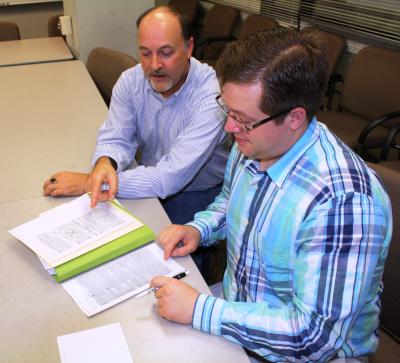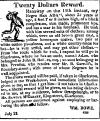Runaway Slave Advertisements Focus of Historical Research Project
Thu, 05/03/2012 - 03:23pm | By: David Tisdale

Two University of Southern Mississippi professors are culling through history's classified section to gain insight into the world of slavery with the support of a $25,000 grant from the National Park Service (NPS).
Dr. Douglas Chambers and Dr. Max Grivno, faculty members in the Southern Miss Department of History, are launching a collaborative research project that will document advertisements in Mississippi newspapers from 1790-1860 placed by masters seeking the capture and return of runaway slaves.
The NPS grant is facilitated through the Lower Mississippi Delta Initiative and the National Underground Railroad Network to Freedom Program, and establishes Southern Miss as an official network partner.
“The Mississippi project is a pilot project,” said Chambers. “We plan to expand our research effort, first to the larger Gulf South and then the rest of the southern U.S. as well as the Caribbean and Brazil.”
According to Chambers and Grivno, the advertisements provide important clues about the life of slaves, their efforts at self-emancipation, and the viewpoints of their masters. Their work will include transcribing the documents verbatim and then organizing them into a full-text searchable online anthology to be made available initially through Southern Miss' electronic repository.
“This anthology will be an absolute gold mine for academic researchers, genealogists and others who want to learn more about this time period, the conditions of slaves and the attitudes of their masters in regard to recovering what they considered their property,” Grivno said.
Newspaper advertisements soliciting information about the whereabouts or sightings of runaway slaves often include first and last names of the slaves and their masters, where they lived, ages, and names of the current and previous slaveholder. Other information may feature reasons why the slave fled, where his destination may be, and features of his personality (for example, one ad describes a slave as “having a sullen look when spoken to”) among other information.
“These advertisements help us see the enslaved as real individuals, not simply as a group,” Chambers said.
Chambers and Grivno note the irony of the advertisements in that, while the slaves were property, their masters expected them to act like people. Advertisements that are part of the project's research material include one that describes a runaway slave by the name of Harry as being a “frequent nocturnal trader,” engaging in the economic activity of selling various goods - even though he was himself a piece of property.
Another ad detailed one slave's flight as driven by a desire “to go to Hinds (County) to ma's….” While others wanted to escape from forced labor, many runaways sought their freedom. Mississippi advertisements even document instances of one-legged runaways.
Reflecting on the significance of the advertisements, newspapers played an important role in the regime of slavery, Chambers said. “Antebellum Mississippi was a print culture,” he said. “There were newspapers all over the state (during this time).”
The outcome of the advertisements varied. Some slaves were killed or injured resisting capture, while others were beaten for their transgression or placed in iron shackles, sometimes in a steel collar or a ball and chain. Their masters might also retaliate against the runaway slave by breaking up the family and selling them off to plantations across the region.
“It's a tragic history, but these ads bring that history to life,” Chambers said.
For more information about the project, e-mail Chambers at douglas.chambersFREEMississippior Grivno at max.grivnoFREEMississippi. For information about the Southern Miss Department of History, online visit www.usm.edu/history
